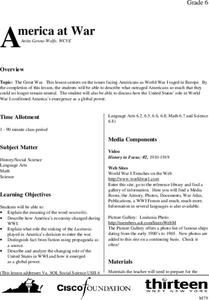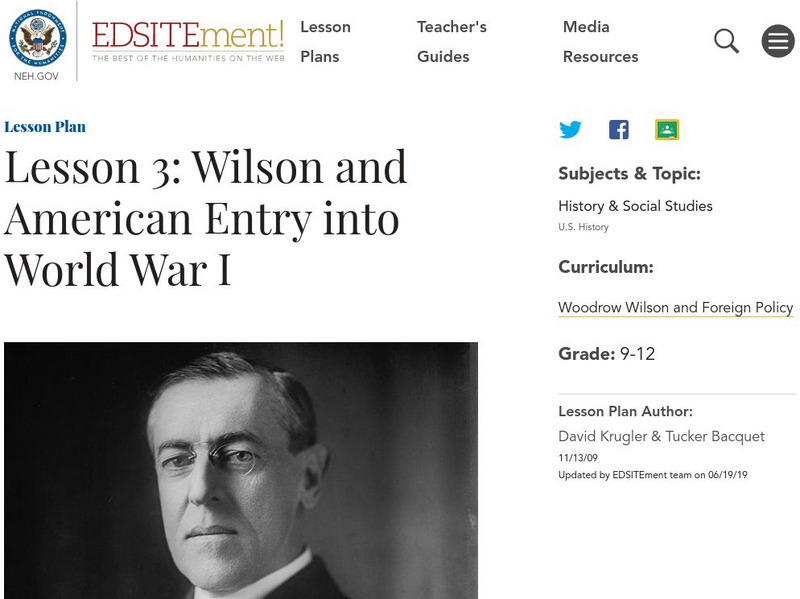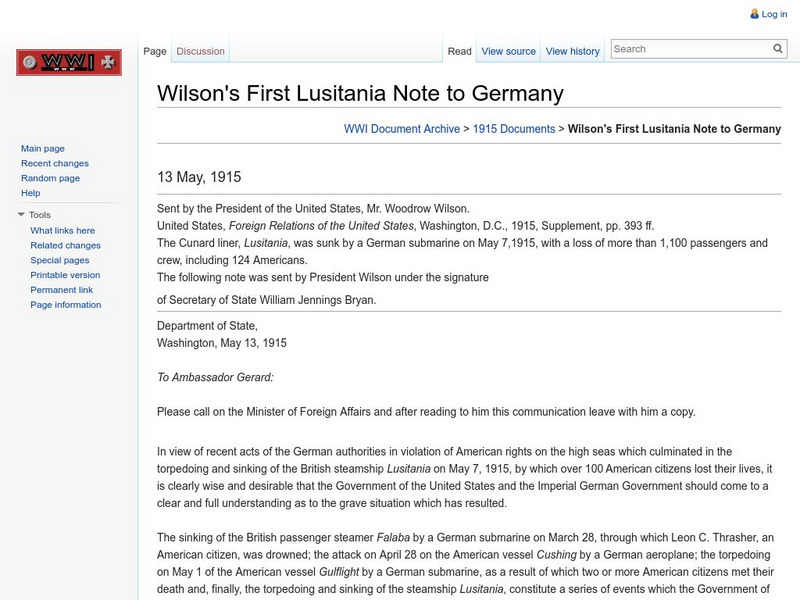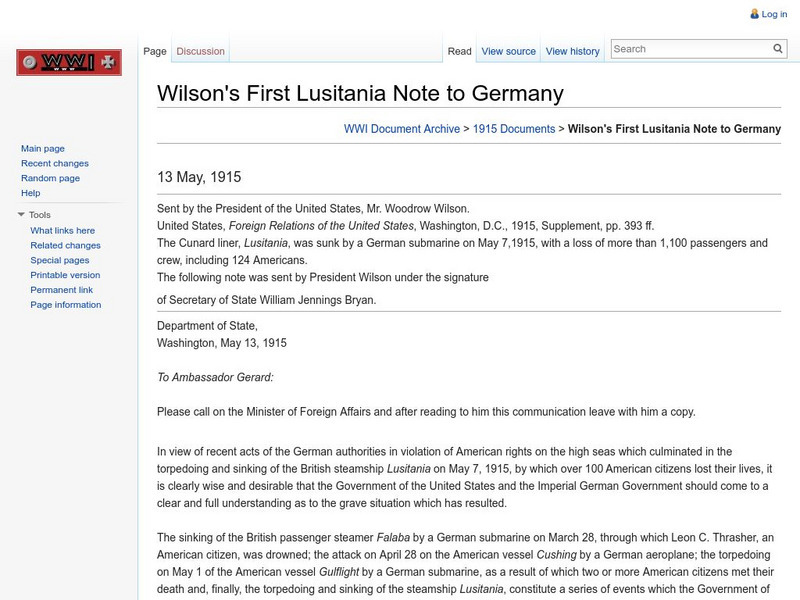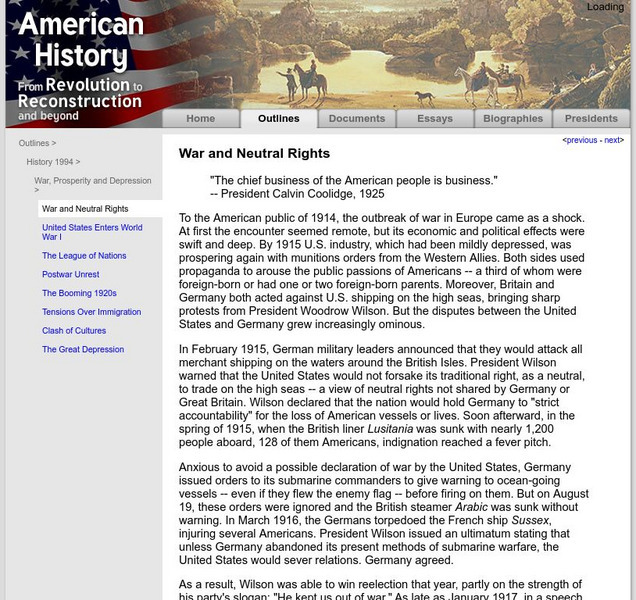Curated OER
United States Entry into World War I: A Documentary Chronology of World War I
Students identify several important events that led to U.S. involvement in World War I. They examine different explanations, form an opinion about the evidence for each rationale and then create a slideshow to present their findings.
Curated OER
History: Causes of World War I
Exploring WWI in an interesting discussion of the key events, this resource could be as a great supplement to a classroom unit on this topic. The pictures and information make this period in history come alive. Students would also...
Curated OER
The Causes and Course of the First World War
Use this twelve-day lesson plan to teach about the causes and courses of WWI. Each day scholars attend lectures, complete creative activities, and hold round table discussions on what they've learned. Web links and resources are...
Curated OER
Global Conflict
Examine the effects and interesting facts regarding global conflict during WWI. Topics covered include The Lusitania, Zimmerman Telegram, the collapse of central powers, and John Pershing. Slides include informative text and images in a...
Curated OER
1914-1918: The World at War
Thorough and engaging, this presentation details the causes and contexts of World War I on all fronts. It covers "the spark" that began it all, as well as the effect of technology on weaponry and the role of women on the home front and...
Curated OER
TB - Lusitania Day (1916)
Students, after brainstorming all the different types of propaganda, explore, analyze and study the nature, origin and purpose of propaganda and how its aims are achieved. They assess how the sinking of the Lusitania was manipulated by...
Curated OER
Lost Liners Scavenger Hunt
Students practice research skills by scouring Internet for facts and information about the lost ocean liners Titanic, Lusitania, and Empress of Ireland.
Curated OER
The Blame Game
Students research the sinking of the Lusitania. They work together to develop a position supporting an idea. They discover principles of international law and the rights of non-combatants in wartime.
Curated OER
America at War
Sixth graders examine issues that faced Americans during World War I, discuss role that sinking of the Lusitania had in America's decision to enter the war, and analyze changing role of U.S. during the war and how it emerged as a world...
Curated OER
Lusitania: Murder on the Atlantic
Students explore the pride of the Cunard line and a jewel in the British crown; a floating four star hotel. But during World War I, the RMS Lusitania carried more than well-to-do travelers luxuriating in her sumptuous appointments.
National Endowment for the Humanities
Neh: Edsit Ement: Woodrow Wilson and Foreign Policy
A thorough review of Woodrow Wilson's foreign policies in these four lessons offered by EDSITEment. Learn the origins of "Wilsonianism," Wilson's views on relations with countries in Latin America, Wilson's decision to enter World War I,...
National Endowment for the Humanities
Neh: Edsit Ement: Woodrow Wilson and American Entry Into Ww I
This lesson plan explores the ways President Woodrow Wilson tried to keep America out of war as World War I raged in Europe. Examine documents, speeches, and other primary sources to follow America's path from neutrality to war.
Brigham Young University
Brigham Young U.: Wwi Document Archive: Wilson's First Lusitania Note to Germany
Read the text of a note sent to the German government by Woodrow Wilson protesting the sinking of the Lusitania.
PBS
Pbs: Lost Liners: Lusitania
PBS documentary about famous shipwrecks reviews the sinking of the Lusitania and the salvage efforts undertaken by deep-sea archaeologist Bob Ballard, who explored the wreckage in 1993.
PBS
Pbs: Lost Liners
Explore this online exhibit on lost ocean liners. Includes the Titanic, Lusitania, Empress of Ireland, Britannic, and the Andrea Doria.
OpenStax
Open Stax: Great War 1914 1919: American Isolationism and European Origins of War
The foreign policy of Woodrow Wilson is explained, and how he tried to keep America neutral at the start of World War I yet intervened in international affairs in the Western Hemisphere. The reasons America declared war on Germany in...
Utah Education Network
Uen: Themepark: Liberty: World War I
Find a large collection of internet resources organized around World War I. Links to places to go, people to see, things to do, teacher resources, and bibliographies.
Brigham Young University
Byu: Wwi Archive: Wilson's First Lusitania Note to Germany: May 13, 1915
This site contains the first Lusitania note sent to Germany by President Woodrow Wilson, under the signature of Secretary of State William Jennings Bryan, May 13, 1915.
University of Groningen
American History: Outlines: War and Neutral Rights
This resource presents a brief discussion of U.S. neutrality early in World War I and of the events which brought the country closer to war.
Digital History
Digital History: Neutrality and the Lusitania [Pdf]
American neutrality in World War I was sorely tested with the attack and sinking of the passenger ship, Luisitania. Read information about the attack and find conflicting reactions by Franklin Roosevelt and William Jennings Bryan about...
Digital History
Digital History: America Goes to War [Pdf]
President Woodrow Wilson tried to maintain American neutrality in World War I. Find out why he decided that the U.S. needed to join the war and read a portion of his message to Congress asking for a declaration of war against Germany....
US National Archives
Nara: Military Resources World War I
A compilation of resources on World War I from the National Archives and Records Administration, including links to external sites.
Then Again
Then Again: Web Chron: The Sinking of the Lusitania
NorthPark University offers several informative paragraphs on the sinking of the Lusitania, a British cargo and passenger ship that was torpedoed and sank due to German submarine activity on May 7, 1915.
PBS
Pbs: The Great War: Interactive Timeline
This site has an interactive timeline of World War I. Choose a year to see important events listed chronologically. You can click on battles and names of famous people to read accompanying thoughts of historians.










